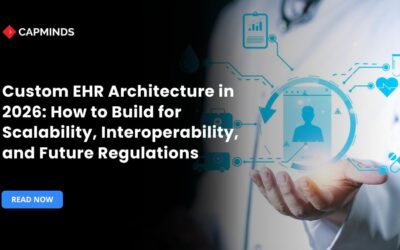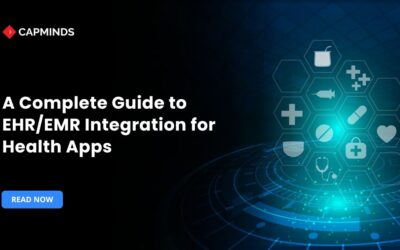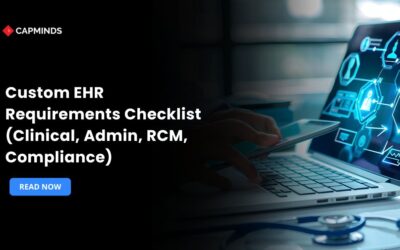Integrating RCM, Telehealth, and Analytics into One Custom EHR Ecosystem
Even though the majority of hospitals and clinics in the modern healthcare environment use EHRs. Many still manage heterogeneous systems for data analytics, telehealth, and billing. This fragmentation creates data silos and workflow inefficiencies. This has an impact on the quality of care and financial results.
A unified, integrated EHR ecosystem solves this problem by connecting RCM, telehealth, and analytics into one interoperable platform. This guide explores practical challenges, implementation strategies, and how custom EHR integration streamlines operations and improves care delivery.
The Vision of an Integrated EHR Ecosystem
A modern custom EHR integration environment brings clinical, financial, and operational capabilities together within one seamless platform. Instead of switching between separate billing software, telehealth tools, and reporting platforms, all systems communicate through shared data standards like HL7 FHIR.
Data may be quickly moved throughout the organization by integrating many systems, like as practice management and billing software, telehealth platforms, and analytics. The objective is to establish a single source of interoperable systems. This provides providers with thorough information and facilitates improved decision-making.
Key Components of an Integrated EHR Ecosystem:
1. Revenue Cycle Management
RCM services include scheduling, billing, insurance verification, claim processing, and payment collection. When RCM is incorporated into the EHR, it combines clinical data and financial data into a unified system.
This consistency eliminates unnecessary data entry and ensures prompt and accurate invoicing based on current clinical documentation. For instance, procedure codes and insurance details noted during a patient visit are immediately loaded into billing, which lowers errors, expedites claims, and boosts cash flow.
2. Telehealth
Telehealth uses virtual visits, remote monitoring, and digital communication to deliver care. When telehealth tools are directly connected to the EHR, physicians can review and modify patient records during virtual consultations.
Through this connection, the workflow for in-person care is expanded to include telemedicine, e-prescribing, video consultations, and remote patient monitoring data. It removes the hassle of transcribing data later or changing systems in the middle of a session. The result is a comprehensive, unified patient record, whether treatment is provided in person or by video, with real-time sharing of notes, vitals, and orders between care venues.
3. Analytics and Business Intelligence
Integrated EHR data analytics tools aggregate information from encounters, claims, wearables, and operational systems. Dashboards and reporting tools help identify care gaps, predict patient risk, and improve financial performance.
Proactive, data-driven care is made possible by these insights: predictive algorithms can identify high-risk patients for early intervention, and dashboards may monitor important quality or revenue metrics in real time. Adding analytics essentially transforms the EHR into a platform for making decisions, moving beyond simple recording to facilitate continuous care and operational enhancement.
Related: How to Integrate EHR Data into Healthcare Analytics Dashboards
Operational Challenges in Integrating RCM, Telehealth, and Analytics into Custom EHR
It is difficult to integrate analytics, telemedicine, and RCM into a single ecosystem. Healthcare institutions have several operational obstacles to overcome:
1. Interoperability and Data Silos
Getting diverse software systems and data formats to “speak the same language” presents a considerable challenge.
- Incompatible data and integration challenges arise as a result of many institutions’ use of diverse legacy systems that were not designed to interface with one another.
- Lack of data standards makes human solutions necessary because providers find it difficult to align and reconcile data from multiple sources.
- To get around this and allow smooth data exchange between telehealth platforms, EHR modules, and RCM systems, compliance with interoperability standards (such as HL7 FHIR) is necessary.
- Without uniformity, important data (lab results, billing codes, remote monitoring readings) might not transfer accurately, increasing the possibility of missing or lost records.
2. Workflow Disruption and User Adoption
Integrating new tools into clinicians’ and staff’s daily routines can initially disrupt workflows. Providers may resist changes if the integrated system alters familiar processes or seems cumbersome, leading to low adoption rates. For example, if merging telehealth with EHR adds extra steps or clicks, busy clinicians might bypass it. Developing integrations that facilitate rather than complicate tasks is the key.
Experienced methods for minimizing disruption and boosting buy-in include phased rollouts, training, and early end-user interaction. Lastly, the connected ecosystem should simplify procedures (such as one-stop paperwork) so that doctors can save time and become less irritated, leading to enthusiastic adoption.
3. Cost and Infrastructure Investment
A substantial investment in IT infrastructure, software development, and project management is required when creating a new EHR ecosystem or integrating many systems.
- Upfront costs for integration – especially for telehealth capabilities or advanced analytics – can be high.
- Due to a lack of funding or internal IT expertise, small and medium-sized practices may find it difficult to fund and maintain such a system.
- By conducting a thorough cost-benefit analysis and searching for incentives (like grants or government programs), the expense can be justified.
- Also, businesses often need to upgrade outdated networks or equipment to support a more data-intensive, integrated platform, which increases the project’s scope.
4. Data Security and Compliance
When RCM, telehealth, and analytics are coupled, a greater volume of sensitive data (clinical records, financial information, video consultations) will be routed through a single system. This makes good security measures even more important. Integration may create new vulnerabilities that expose patient data if interfaces or APIs are not adequately secured.
Because infractions of healthcare privacy rules, including HIPAA, can result in severe penalties and compromise patient confidentiality, they must be strictly adhered to.
Healthcare CIOs are in charge of making sure that any integrated system has robust user access controls, frequent security audits, and end-to-end encryption of data both at rest and in transit. A unified platform (one system to audit instead of several) can facilitate compliance, but only if security is integrated from the start.
5. Scalability and Performance
As integrations grow (more users, more telehealth sessions, bigger data volumes), the system must grow without slowing down or crashing. A small clinic’s EHR-telehealth interface might work well with 20 virtual visits a week, but can it handle 2000 at a large hospital?
Poorly scalable integrations generate lag and downtime that hinder care delivery. Growth planning is critical, load balancing and a cloud-based, modular design can ensure that the platform remains reliable and fast even as demand grows.
As the ecosystem grows, IT teams may optimize infrastructure and provide a consistent user experience by discovering bottlenecks early on through continuous performance monitoring.
6. Change Management
Lastly, the clinical, billing, IT, and administrative divisions are all impacted by system integration. It requires coordinated change management.
- Staff training is required for new procedures, and job roles may change (e.g., less time spent on manual data entry, more time spent on patient interaction).
- Without clear communication and strong leadership backing, human factors can lead to the failure of even the strongest technology integration.
- Successful initiatives view integration as a strategic endeavor, look for leadership sponsorship (CIO/CTO, CMIO), and involve end users (nurses, doctors, billing staff) throughout the entire transformation process.
Key Considerations for Implementation Process
Integrating analytics, telemedicine, and RCM into a custom EHR platform requires significant effort. Healthcare IT leaders should take a systematic strategy to avoid risks while increasing rewards. Here are key implementation considerations:
1. Define Clear Goals and Scope
Determine your goals for integration first.
- Are you looking to improve care coordination, increase telehealth use, reduce claim denials, or all three?
- Setting specific targets and performance indicators will lead your project and allow you to quantify ROI (e.g., reducing denial rates to less than 5%, doubling telehealth volume, improving patient satisfaction scores).
- Also, determine the scope – which workflows and departments to integrate first.
Many organizations prioritize high-impact areas like electronic claims submission or integrating virtual visit documentation, then expand to additional processes in phases.
2. Ensure Interoperability from the Outset
Verify whether your current EHR, billing, and telemedicine systems are compatible. If your systems use common standards like HL7 or FHIR or have strong data exchange APIs, integration will be much simpler. If not, you may need middleware or an interface engine to translate between systems.
Choosing integration tools or a platform that aligns with your existing software is critical – it serves as the “bridge” for reliable, secure data sharing. Make sure that any new analytics or telehealth modules adhere to industry interoperability standards so they may be integrated into the ecosystem without requiring a lot of special development.
Recall that interoperability maintains processes between modules seamlessly and stops data silos from reemerging, making it more than just a technical perk.
3. Map and Cleanse Your Data
Integration won’t work if the underlying data is inconsistent or poorly mapped across systems. Take some time to describe the data flows for patient, clinical, and financial data that must occur between point A (the EHR) and point B (RCM or analytics).
- Make sure, for instance, that the patient ID in the telehealth system matches the ID in the EHR or that the billing codes in the clinical module match the appropriate fields in the finance module.
- This often necessitates data standardization and transformation, which involves changing codes or formats so that both systems can understand them appropriately.
- Before going live, it’s a good idea to perform data cleansing and deduplication procedures to remove errors.
- For troubleshooting and future upgrades (such as when billing codes change), data translations must be fully documented.
4. Prioritize Privacy and Security
Security must be incorporated into the design of unifying systems. Work with your compliance professionals to ensure that the integrated architecture complies with HIPAA and other regulations at every stage.
Encrypt data as it travels between systems and while it is at rest in databases. Establish strong role-based access restrictions, such as permitting a clinician to review medical data and only billing personnel to read financial information. Perform security risk assessments and penetration tests on newly developed modules or interfaces.
The integration of telehealth into your EHR indicates that it is now subject to the same audit and backup regimes as the rest of your data, which can simplify compliance if done correctly. It is also crucial to coordinate the connection with your organization’s security policies. You can safeguard patient information, maintain trust, and profit from integration by putting security first.
Related: What Should Be in Your 2025 Health IT Security Audit Checklist
5. Engage End-Users and Invest in Training
Physicians, nurses, billers, and schedulers – all the people who will actually use the integrated system – should be involved early and often.
- Get feedback on their workflow requirements and problems so that the customized EHR ecosystem can be adjusted appropriately.
- Throughout the installation process, offer thorough training that covers both new software capabilities and workflow practices (e.g., how a telehealth note now instantly triggers a billing event).
- Plan for help and anticipate a learning curve, assign super-users or a help desk to assist staff in adjusting.
- By outlining the advantages of the change, such as “this integration will save you X hours of administrative work each week,” users can be convinced to embrace it.
- Keep in mind that the adoption of technology in the healthcare industry depends on its usability; if the integrated system makes providers’ jobs easier, they will quickly become its strongest supporters.
6. Phased Rollout and Testing
Avoid a “big bang” go-live if possible. It’s safer to implement the integration in stages – for example, start with linking EHR and RCM for one department, or piloting the telehealth-EHR interface with a small patient group. Use a sandbox environment to conduct end-to-end testing of each integrated workflow before full deployment.
To guarantee that data updates everywhere are accurate and without latency, this should encompass edge circumstances such as a telehealth visit followed right away by an in-person lab test. You can identify problems early and improve the system without interfering with all operations by running a prototype program or a parallel run. Staff can adjust in small steps when the deployment is gradually expanded.
Have backup preparations (such as access to the previous system) in case something goes wrong, and schedule the go-live during off-peak times. A planned, phased approach lowers risk and boosts confidence as the integrated ecosystem comes online.
7. Continuous Monitoring and Optimization
Go-live does not signal the end of implementation. Key performance measures such as claim denial rates, telehealth no-show rates, user happiness, and system reaction times should be monitored to evaluate the integrated ecosystem’s success.
- Ask staff and clinicians for their thoughts: Are there any new bottlenecks?
- Does the analytics dashboard really aid in making decisions?
Iterate and improve using these findings. Maintain all software components up to date and schedule routine maintenance updates. A custom EHR ecosystem should be seen as a dynamic system that will need to be expanded and updated as the healthcare industry changes as a result of new laws and cutting-edge technologies like artificial intelligence.
By continuously maintaining and optimizing the integrated platform, you can guarantee that it will continue to deliver value, leading to long-term high-quality care and effective operations.
Empower Your Healthcare Operations with CapMinds’ Integrated Digital Health Services
Transform your healthcare ecosystem with CapMinds’ complete digital health tech services and solutions, built to unify your clinical, financial, and operational workflows into one seamless platform.
We specialize in creating custom-integrated EHR ecosystems that connect every aspect of your organization for better care, efficiency, and profitability. With CapMinds, you gain:
- RCM Services – Streamline billing, claims, and collections for faster reimbursements.
- Telehealth Solutions – Deliver secure, connected virtual care directly within your EHR.
- Healthcare Analytics & Business Intelligence – Unlock actionable insights to drive smarter decisions and improved outcomes.
- Interoperability & Data Integration Services – Ensure all systems communicate efficiently and compliantly.
- EHR Customization & Implementation Support – Tailored, scalable platforms that grow with your practice.
Partner with CapMinds Services to build a truly connected, future-ready digital health ecosystem that empowers providers and enhances patient experiences.




